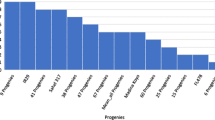Abstract
Quantitative trait loci (QTLs) contributing to salt tolerance during the vegetative stage in tomato were investigated using an interspecific backcross between a salt-sensitive Lycopersicon esculentum breeding line (NC84173, maternal and recurrent parent) and a salt-tolerant Lycopersicon pimpinellifolium accession (LA722). One hundred and nineteen BC1 individuals were genotyped for 151 RFLP markers and a linkage map was constructed. The parental lines and 119 BC1S1 families (self-pollinated progeny of the BC1 individuals) were evaluated for salt tolerance in aerated saline-solution cultures with the salt concentration gradually raised to 700 mM NaCl+70 mM CaCl2 (equivalent to an electrical conductivity of approximately 64 dS/m and a water potential of approximately −35.2 bars). The two parental lines were distinctly different in salt tolerance: 80% of the LA722 plants versus 25% of the NC84173 plants survived for at least 2 weeks after the final salt concentration was reached. The BC1S1 population exhibited a continuous variation, typical of quantitative traits, with the survival rate of the BC1S1 families ranging from 9% to 94% with a mean of 51%. Two QTL mapping techniques, interval mapping (using MAPMAKER/QTL) and single-marker analysis (using QGENE), were used to identify QTLs. The results of both methods were similar and five QTLs were identified on chromosomes 1 (two QTLs), 3, 5 and 9. Each QTL accounted for between 5.7% and 17.7%, with the combined effects (of all five QTLs) exceeding 46%, of the total phenotypic variation. All QTLs had the positive QTL alleles from the salt-tolerant parent. Across QTLs, the effects were mainly additive in nature. Digenic epistatic interactions were evident among several QTL-linked and QTL-unlinked markers. The overall results indicate that tomato salt tolerance during the vegetative stage could be improved by marker-assisted selection using interspecific variation.
Similar content being viewed by others
Author information
Authors and Affiliations
Additional information
Received: 4 January 1999 / Accepted: 4 January 1999
Rights and permissions
About this article
Cite this article
Foolad, M., Chen, F. RFLP mapping of QTLs conferring salt tolerance during the vegetative stage in tomato. Theor Appl Genet 99, 235–243 (1999). https://doi.org/10.1007/s001220051229
Issue Date:
DOI: https://doi.org/10.1007/s001220051229



